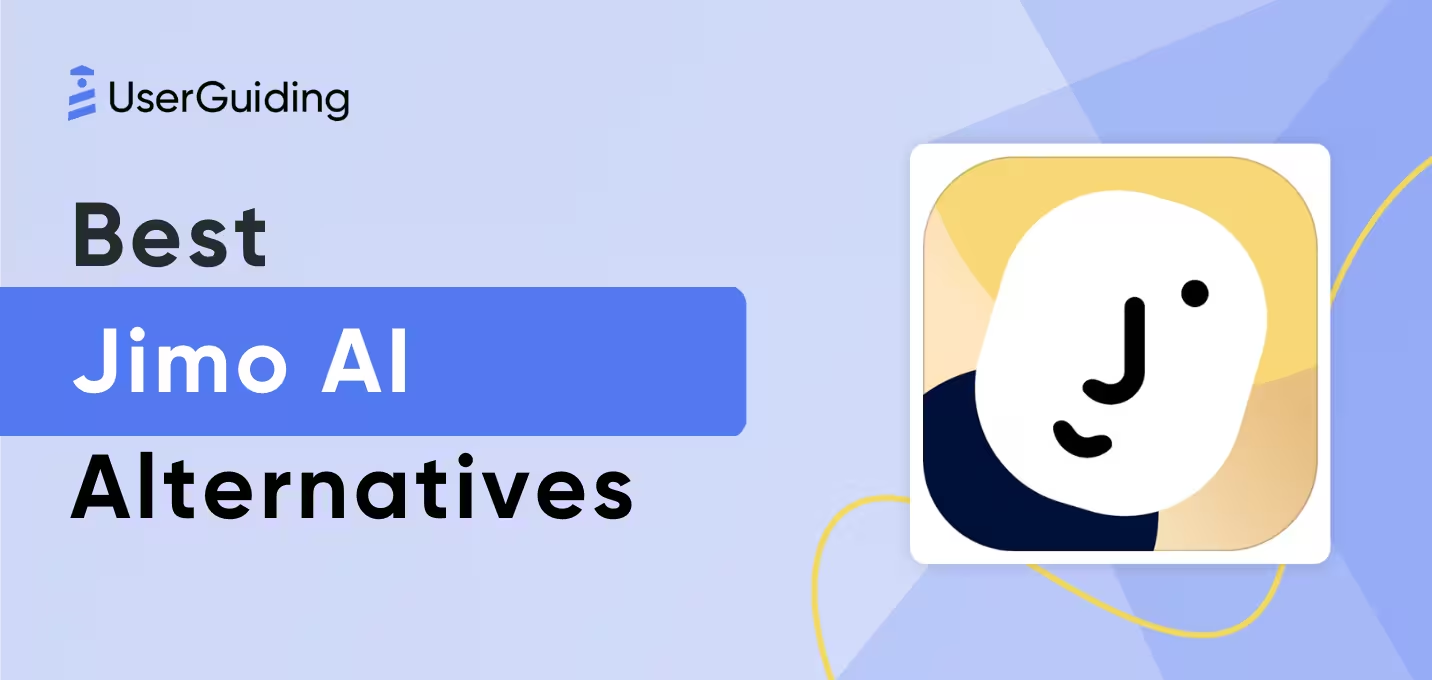

Low-code onboarding solutions can improve the user experience and make product promotion easier.
Let me give you some data before diving into the topic.
Here's something interesting: Gartner predicts that by 2025, 70% of organizations will use low-code or no-code platforms for their applications.
Just five years ago, that number was only 25%.
That's a massive shift! And it can make you feel you should just do it. Still, creating a development process yourself takes a lot of resources, even if it’s low-code. I have to say that even if low-code is amazing for many tasks, onboarding may not be among them.
You have to be very careful about your onboarding, as poor onboarding is one of the top three reasons for customer churn.
We will talk about all of these in this article so you can make an informed decision. Let’s start!
TL;DR
- Low-code onboarding solutions help you build your own onboarding experience with a minimum of coding, but still, it’s a developing process.
- Drag-and-drop interface, prebuilt templates, integration capabilities, and customization options make low code useful.
- However, you can also consider two other options:
- Developing from scratch
- Working with a 3rd party tool
- UserGuiding allows you to launch your user onboarding, covering all the features you need without any coding.
What are low-code platforms?
Imagine being able to start any development project with a minimum of coding knowledge. How much easier would that make things for your business?

Low-code platforms make this real. These systems let you build apps, websites, and interfaces without much technical know-how.
You just need to use a simple drag-and-drop interface – basically as easy as dragging a file into a folder on your computer.
It's no surprise that companies across all industries are embracing low-code platforms.
In fact, 83% of CIOs are turning to them due to the increasing difficulty of hiring technical talent. When speed and efficiency are critical, moving to low code is a smart move to save time and reduce costs.
What can low-code do for onboarding processes?
Low-code can:
- Build product adoption walkthroughs,
- Create forms, lists, and product promotions with a drag-and-drop interface
- Set up different workflows for different user roles
- Provide detailed tutorials to help users learn your products and programs
- Manage email and subscription forwarding
- Add onboarding modules to provide step-by-step instructions on how to use the application
- Gather feedback by setting up surveys
One of the great things about low-code onboarding is that integration errors are almost nonexistent. You can connect to your CRM, email marketing, or other systems and monitor the flow of data in real-time.
Plus, you can test and fine-tune your onboarding flow before going live to ensure its perfection.
However, to achieve a complete onboarding experience, you will still need a lot of work. That’s because an onboarding experience requires many features, including product tours, tooltips, hotspots, a knowledge base, surveys, and more.

Key Features of Low-Code Onboarding Solutions
Even though you will need coding at some point while using low-code solutions, they still provide useful features. Let’s explore low-code onboarding solutions a bit more.
Drag-and-drop interface

Drag-and-drop is a super handy feature in design tools. Want to move a button? Just grab it and drag it anywhere on the screen.
This method allows you to create the interface you need in minutes, which is a tremendous time saver.
Pre-built templates and components
If you're not skilled enough to build an interface from scratch, you will want to use pre-built templates and components in your onboarding process.
You can just take a look at the ready-made templates offered by the platforms, get ideas, and customize your onboarding elements with just a few changes. However, this may limit you if you have something specific in your mind and no skilled developers and designers.
Integration capabilities
With low-code software, you can easily integrate other applications. So, you can quickly add third-party tools to your system.
This increases your productivity without messing with your current setup. And because the data is transferred in real-time, you don’t miss a thing.
Customization options
Customization makes your onboarding process align with your branding and also improves the user experience while onboarding.
That's why it's important to offer a wide range of customization options for interface enhancements. With low-code software, you can redesign your user experience and make it more efficient as long as the platform allows you to.
How to Implement a Low-Code Onboarding Solution
So, let's talk about how to implement a low-code onboarding solution. There are 4 main steps I want to cover in this article.
Select an appropriate low-code platform
First, you need to choose the right platform. This step is key to streamlining the process of building your onboarding experience.
Make sure the platform integrates with your existing systems. You don't want to break any functionality.
Security is also critical. Look for features such as authentication, data encryption, and access control.
If your company operates globally, look for multilingual support to increase conversion rates.

Consider scalability. Choose a platform that will grow with you. Compatibility across devices (computers, tablets, and phones) is a must.
Finally, compare pricing carefully to make sure it fits your budget. Remember, you don't have to commit right away - trial periods exist for a reason.
Assess current onboarding processes
Now, take a step back and evaluate your current onboarding process. Is it efficient? If not, don't get stuck.
There are low-code solutions that are simple, cost-effective, and secure. Start by reviewing the user experience. Gather feedback to know what's not working. A simple NPS survey can be your ally.

Discuss the problems with your team. Someone may catch a detail you missed. Once you identify the problems, you can move forward with the right low-code solution.
Design the onboarding workflow
Even if you provide various steps, each step should take the user to a desired destination, which is usually product adoption.
That’s why you need to design the onboarding process as you’re telling a story. Let the first step prepare people for the next one so they will know what they are doing.
A progress bar, aka onboarding checklist, can help users track their progress and encourage them to complete the process.
Here is the example from UserGuiding to inspire you.👇

Make sure the design works well on both desktop and mobile. A misplaced button or slow load time can frustrate users and hurt your onboarding process.
Test and iterate
Testing is essential. Yes, it can feel tedious, but it's critical to catch potential problems.
Check if the buttons are in the right place and the pages are loading fast enough. The average attention span is only 8 seconds, so speed is key.
Optimize your onboarding experience whenever you need to do so. You can’t just ignore difficulties while your users are trying to adopt your product.
2 alternatives to a low-code onboarding solution
Every company needs its own onboarding solution. Well, not all of them can just use the same system. It's really important to look at different options to find what works best for you.
So here's the deal: you can either build your own onboarding solution (with low-code or traditional methods) or use third-party tools (usually no-code).
No matter which path you take, make sure your solution helps increase those conversion rates and product adoption.
Developing from scratch with your own team
You can hire developers to write code to build your onboarding system. This is the traditional method, but it’s the most expensive and time-consuming option.
Even if you use a pre-built onboarding library, you will need developers and designers to make it work.
Therefore, you need a good reason to do this.
For example, if you've been thinking about developing your onboarding process with your team, you may have some concerns about the scalability of low-code solutions. Maybe it's the customization that makes you think about this option.
Working with a 3rd party tool focusing on onboarding
Third-party tools are the best way to quickly start onboarding your users and simplify complex processes.
They are packed with the necessary features to onboard your users. Even though each tool focuses on something different, they mostly promise an easy and quick way to launch your onboarding experience.
If you will use a checklist, all you need to do is add your text and customize the checklist according to your branding.
If you need to announce new features, you will have various options to do it including in-app announcement banners aka sticky headers, and a product updates page.
UserGuiding is one of the onboarding solutions that makes a good alternative to low-code onboarding solutions.
People love the practical features of UserGuiding. You don't need to know any coding, and the user-friendly interface makes it possible to create even complex processes like a knowledge base in just a few days.

Pros and cons of low-code onboarding solutions
Now that you know your options, let’s dive deeper into the topic.
Low-code onboarding solutions have pros and cons. Therefore, it is very important to consider all aspects before proceeding to the decision phase.
The information below will help you analyze whether you need low-code onboarding solutions.
Pros
Low code is a safe choice for enterprise software developers. According to a study published in Forrester, 87% of enterprise developers use low code in some parts of their workflow.
1. Reduced development time compared to manually coding your onboarding
Traditional onboarding processes can slow your business down by wasting the time of development teams. Low code is a faster and easier-to-implement solution that can accelerate application development by up to 10 times.
2. Cost-effectiveness comparing to manually coding your onboarding
If you're using low-code platforms in your projects, you want to get multiple services. But you're not sure if you want to do it through one platform. Low-code is a cost-effective solution, but 3rd parties are better at this.
For example, UserGuiding offers ideal pricing for companies of all sizes. Thanks to the subscription system, it's ready to go.

Cons
We've talked about the great features of low-code platforms, but what about the cons?
1. Limited customization for complex processes
Ready-made components on low-code platforms offer great convenience and ease for most projects. However, it is not true to say that they will be 100% effective in complex projects.
Low-code, off-the-shelf components may be limited and may not fully meet complex project requirements. Therefore, it is worth consulting with your team to develop projects with unique elements.
2. Dependency on the chosen platform and developers
One of the disadvantages of low-code platforms is that they make you dependent. For example, you designed an onboarding process to familiarize your users with a product.
However, after an update, you may still need to use the same platform to change your onboarding process. This is also a challenge when there are people changes in your development team.
3. Learning curve for non-technical staff
Developers will create your onboarding process with a low-code platform. But after that, you also need to educate your teams, who will need to work on this process. You may need another onboarding for your team 🥲
If your interface is not simple enough, it can be hard for non-technical staff to understand how to change items. This can be time-consuming before you launch your onboarding experience.
Future considerations when you opt for low-code solutions
You've found a low-code platform, and you like what you see, but you have a few questions:
- Is it scalable?
- Can I use it for other business processes?
- Is it possible to review and improve the experience?
Let's go over what you should be looking for.
1. Scalability of the solution
The flexibility of low-code onboarding solutions is highly dependent on the platform you use. The platform's scalability issues can lead to various errors that may not be able to accommodate the business's growth and needs.
UserGuiding stands out with its scalable user and product onboarding solutions. It's designed to grow with your business, so you’ll have fewer headaches down the road. Just saying.
Potential for expanding to other business processes
The low code onboarding solution could potentially be used for more than just onboarding new users - or employees in some cases.
The solution's flexibility and adaptability could allow you to apply it to other areas of a business, such as customer service, sales, or even HR processes like performance reviews or time off requests.
The solution you will choose should not be limited to just the initial onboarding process. Also make sure that you can easily add elements that you may need in the future. Consider this before working on it.
Monitoring and improving the onboarding experience
So, you're going through a new onboarding process and want to know how the tool is working. This statistic lets you go slow and ensure that you're always giving your users the best experience.
You need to test your onboarding before you publish, and then track your statistics after you've published. In this future step, you will want to get instant and accurate statistics because the data is all in sync.
With both data and testing, you can improve the user experience in no time.
Conclusion
In short, low-code solutions can be great for onboarding in some cases. But they may struggle to meet your needs down the road.
Before diving into it, you need to know what you will really need in the next steps and consider your time, budget, and requirements.
UserGuiding has a simpler interface than what you can do with low-code, and it's flexible, scalable, and cost-effective. Plus, it gives you more peace of mind about the concept of "scalability," which is a big concern for most business owners.
Even when you try it for 14 days, you will complete many tasks easily. Go for it!
Frequently Asked Questions
Can low-code platforms handle complex onboarding workflows?
Yes, low-code platforms come with pre-built components and logic flows that you can easily customize to handle complex, multi-step onboarding processes.
How customizable are onboarding solutions built with low-code tools?
Low-code platforms are flexible, with drag-and-drop functionality and custom scripting options, so you can create tailored onboarding experiences based on what users need.
Can I integrate my onboarding solution with other systems using a low-code platform?
Yes, low-code platforms often come with API integrations so you can easily connect to a CRM, marketing tools, and other third-party systems.
Are onboarding solutions with low-code platforms safe?
Most low-code platforms follow industry-standard security protocols, but it's important to properly configure user authentication, data encryption, and access controls.

















.svg)
.svg)
.svg)
.svg)
.svg)

.svg)
.svg)












.svg)
.svg)




.png)
















